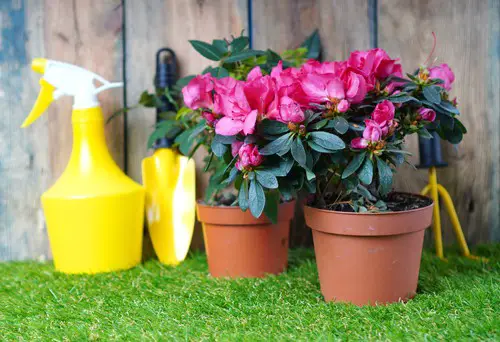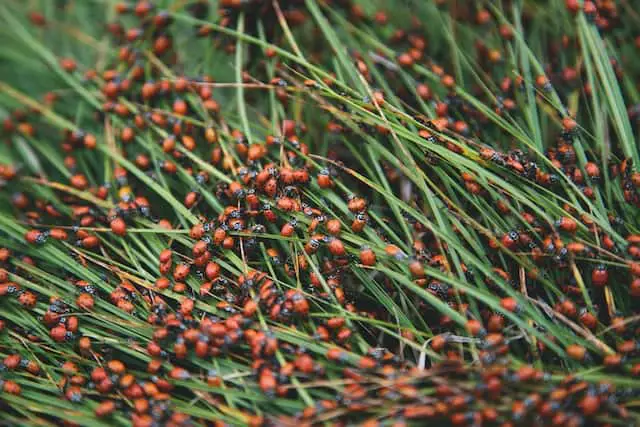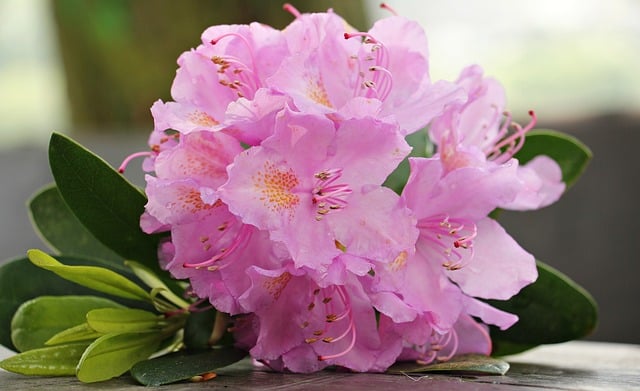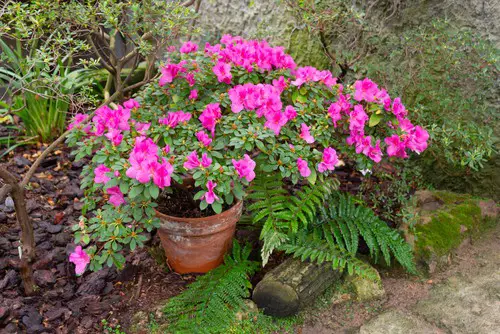Azaleas are beautiful shrubs that are popular in gardens for their vibrant colors and delicate blooms. However, these plants are also prone to developing brown spots on their leaves, which can be a sign of a variety of issues. Understanding the causes of Azalea Brown Spots on Leaves is crucial for maintaining the health and beauty of your plants.
Common causes of brown spots on azalea leaves include fungal diseases, pest infestations, environmental factors, and nutrient deficiencies. Identifying the specific cause of the brown spots is essential for determining the appropriate treatment.
Fortunately, there are many steps you can take to prevent and treat brown spots on your azaleas, including proper care and maintenance, choosing resilient varieties, and addressing any underlying issues.
Key Takeaways
- Brown spots on azalea leaves can be caused by a variety of factors, including fungal diseases, pest infestations, environmental factors, and nutrient deficiencies.
- Identifying the specific cause of brown spots is crucial for determining the appropriate treatment.
- Proper care and maintenance, choosing resilient varieties, and addressing any underlying issues can help prevent and treat brown spots on azalea leaves.
Also see:
- Avocado Plant Brown Spots on Leaves:
- Arrowhead Plant Brown Spots on Leaves:
- Anthurium Leaves Brown Spots
Understanding Azalea Brown Spots on Leaves

Azaleas are a popular flowering shrub that can add color and beauty to any garden. However, azaleas are prone to various diseases that can cause brown spots on their leaves, which can be an eyesore and a sign of a health problem. In this section, we will discuss the causes and symptoms of azalea brown spots and how to manage them.
Symptoms of Azalea Brown Spots
Azalea brown spots typically appear as small, circular or irregular-shaped brown or reddish-brown spots on the leaves. The spots may have a yellow or green halo around them, and they may be surrounded by a yellowing or browning of the leaf tissue.
In severe cases, the spots may merge to form larger patches, and the leaves may become distorted or drop prematurely.
Causes of Azalea Brown Spots
Azalea brown spots can be caused by several factors, including fungal and bacterial diseases, insect infestations, and environmental stress. One of the most common fungal diseases that cause brown spots on azalea leaves is azalea leaf spot, which is caused by the fungus Ovulinia azaleae.
This disease is more common in humid and wet conditions and can spread rapidly in crowded and damp environments.
Environmental stress, such as drought, heat, and cold, can also cause brown spots on azalea leaves. Insect infestations, such as lace bugs and spider mites, can also cause brown spots by feeding on the leaves and sucking the sap out of them.
Managing Azalea Brown Spots
The management of azalea brown spots depends on the underlying cause. If the brown spots are caused by a fungal disease, the affected leaves should be removed and destroyed, and a fungicide should be applied to prevent further spread of the disease.
It is also important to improve air circulation around the plants and avoid overhead watering to reduce humidity.
If the brown spots are caused by environmental stress, watering the plants regularly and providing shade during hot and dry weather can help. Insect infestations can be controlled by applying insecticides or using natural predators such as ladybugs and lacewings..
Common Azalea Diseases

Azaleas are susceptible to various diseases that can cause brown spots on the leaves. The following subsections describe some of the most common azalea diseases.
Fungal Diseases
Fungal diseases are common in azaleas, and they can cause brown spots on the leaves, flowers, stems, and roots. Some of the most common fungal diseases that affect azaleas include:
- Leaf spot: This disease causes brown spots on the leaves, and it is caused by various fungi. Leaf spots can be circular or irregular in shape, and they may have a dark border. In severe cases, the leaves may turn yellow and drop prematurely.
- Gall: Azalea gall is caused by a fungus that infects the stems, causing them to swell and form galls. The galls may be green, pink, or red, and they may contain spores that can infect other parts of the plant.
- Wilt: Azalea wilt is caused by a fungus that infects the roots, causing them to rot. The plant may appear wilted, and the leaves may turn yellow or brown.
- Rust: Azalea rust is caused by a fungus that affects the leaves, causing yellow or orange spots on the upper surface and brown spots on the lower surface. The spots may be surrounded by a yellow halo.
Fungal diseases can be controlled by removing infected plant material and applying fungicides. However, prevention is the best strategy, and it involves maintaining good plant health, avoiding overhead watering, and pruning the plant to improve air circulation.
Bacterial and Other Diseases
Azaleas can also be affected by bacterial and other diseases that can cause brown spots on the leaves. Some of the most common bacterial and other diseases that affect azaleas include:
- Petal blight: This disease affects the flowers, causing them to turn brown and mushy. It is caused by a fungus that infects the flowers during wet weather.
- Crown rot: Crown rot is caused by various fungi and bacteria that infect the base of the plant, causing it to rot. The plant may appear wilted, and the leaves may turn yellow or brown.
- Phytophthora root rot: This disease is caused by a water mold that infects the roots, causing them to rot. The plant may appear wilted, and the leaves may turn yellow or brown.
Bacterial and other diseases can be controlled by removing infected plant material and applying appropriate fungicides or bactericides. However, prevention is the best strategy, and it involves maintaining good plant health, avoiding overhead watering, and planting azaleas in well-drained soil.
Pest Infestation and Azaleas

Common Azalea Pests
Azaleas are prone to pest infestations, which can cause brown spots on leaves. Some of the most common pests that affect azaleas include lace bugs, mites, rhododendron borers, and scale insects.
Lace bugs are the most common pest that affects azaleas and can cause brown spots on leaves. These insects feed on the underside of the leaves, causing a discoloration that can range from yellow to brown. Mites, on the other hand, are microscopic insects that can cause leaf discoloration and damage, which can lead to brown spots on leaves.
Rhododendron borers and scale insects are also common pests that can affect azaleas. Rhododendron borers are a type of beetle that feeds on the bark of the plant, causing it to wilt and die. Scale insects, on the other hand, are small insects that feed on the sap of the plant, causing leaf discoloration and damage.
Preventing and Treating Pest Infestations
Preventing pest infestations is the best way to avoid brown spots on azalea leaves. Regularly inspecting the plant for signs of pests is important, as early detection can prevent the spread of infestations.
Insecticides and insecticidal soaps can be used to treat pest infestations. However, it is important to use these products carefully and according to the instructions, as they can be harmful to the plant and the environment. Insecticides should only be used as a last resort, after all other methods of pest control have been exhausted.
In addition to using insecticides, pruning and removing affected parts of the plant can also be effective in controlling pest infestations. Keeping the plant healthy and well-watered can also help prevent infestations, as healthy plants are less susceptible to pests.
Environmental Factors Causing Brown Spots
Azaleas are susceptible to brown spots on their leaves, which can be caused by a variety of environmental factors. Understanding these factors can help gardeners prevent and treat brown spots on their azaleas.

1. Watering Issues
One of the most common causes of brown spots on azalea leaves is improper watering. Overhead watering, especially in the evening, can lead to moisture sitting on the leaves overnight, which can encourage fungal growth and lead to brown spots.
On the other hand, under-watering can cause stress to the plant, leading to brown spots and other issues. It is important to keep the soil moist but not waterlogged, and to avoid getting water on the leaves when watering.
2. Weather and Wind Effects
Azaleas can be affected by extreme weather conditions, especially during the winter months. Frost damage can cause brown spots on leaves, as can wind damage. It is important to protect azaleas from harsh weather conditions by covering them with frost blankets or moving them to a more sheltered location.
3. Sunlight and Azaleas
Azaleas prefer indirect sunlight, and too much direct sunlight can cause brown spots on leaves. It is important to plant azaleas in a location that receives morning sun and afternoon shade. If an azalea is in a location that receives too much direct sunlight, it may be necessary to move it to a more shaded location.
Nutrient Deficiencies and Azaleas
Recognizing Nutrient Deficiencies
Azaleas are susceptible to nutrient deficiencies, which can cause brown spots on leaves. One of the most common nutrient deficiencies in azaleas is iron deficiency, which causes yellowing of leaves with green veins. Another common deficiency is nitrogen deficiency, which causes the leaves to turn yellow or red.
Other signs of nutrient deficiencies in azaleas include stunted growth, poor flowering, and leaf drop. If you notice any of these symptoms, it is important to diagnose the problem and correct the nutrient deficiency as soon as possible.
Correcting Nutrient Deficiencies

The first step in correcting nutrient deficiencies in azaleas is to identify the specific nutrient that is lacking. This can be done through a soil test or by observing the symptoms and matching them to a deficiency chart.
Once the nutrient deficiency has been identified, the appropriate fertilizer can be applied. For example, iron deficiency can be corrected by applying a chelated iron fertilizer. Nitrogen deficiency can be corrected by applying a nitrogen-rich fertilizer.
It is important to follow the fertilizer instructions carefully to avoid over-fertilization, which can cause fertilizer burn and further damage the plant. In addition, azaleas prefer acidic soil, so it may be necessary to add soil sulfur to lower the pH if the soil is too alkaline.
Proper soil drainage is also important for preventing nutrient deficiencies in azaleas. Poor drainage can lead to waterlogged soil, which can cause root rot and prevent the roots from absorbing nutrients. If the soil is poorly drained, it may be necessary to improve drainage by adding organic matter or creating a raised bed.
Azalea Care and Maintenance
Azaleas are beautiful shrubs that require proper care and maintenance to thrive. Here are some tips to ensure your azaleas stay healthy and free from brown spots on their leaves.
Pruning Azaleas
Pruning is an essential part of azalea care. It promotes new growth and helps maintain the plant’s shape. Improper pruning can cause stress to the plant and lead to distorted growth.
To properly prune an azalea, wait until after it has finished blooming. Then, remove any dead or diseased leaves and branches. Use sharp pruning shears and make clean cuts at a 45-degree angle. Avoid cutting into the woody part of the stem, as this can cause damage.
Feeding and Fertilizing Azaleas
Azaleas require proper feeding and fertilizing to grow strong and healthy. Use a slow-release fertilizer specifically formulated for azaleas, and apply it according to the manufacturer’s instructions. Over-fertilizing can cause stress to the plant and lead to brown spots on the leaves.
Proper Mulching Techniques
Mulching is an important part of azalea care. It helps retain moisture in the soil and suppresses weed growth. Use organic mulch, such as pine needles or bark, and apply it to a depth of 2-3 inches. Avoid piling mulch up against the trunk of the plant, as this can cause damage.
Choosing Resilient Azalea Varieties

When selecting azaleas, it is important to choose varieties that are resilient to brown spots and other diseases. This will help ensure that your azaleas remain healthy and vibrant throughout the growing season.
Resistant Azalea Varieties
Some azalea varieties are more resistant to brown spots than others. For example, the Encore series of azaleas are known for their disease resistance. These azaleas bloom in the spring and again in the fall, providing a long season of colorful flowers. Another variety to consider is the Gumpo azalea, which is a low-growing, spreading evergreen that produces pink or white flowers in the spring.
Growing Conditions for Healthy Azaleas
In addition to selecting disease-resistant varieties, it is important to provide the right growing conditions for your azaleas. Azaleas prefer full sun to partial shade, and they should be planted in well-draining soil that is rich in organic matter. Watering is also important, and azaleas should be kept moist but not waterlogged.
To help prevent brown spots and other diseases, it is important to keep your azaleas healthy and stress-free. This means providing adequate water and nutrients, as well as pruning to promote air circulation and prevent overcrowding.
Frequently Asked Questions
How can I prevent brown spots from forming on my azalea leaves?
Preventing brown spots on azalea leaves requires proper care and maintenance of the plant. Be sure to plant azaleas in well-draining soil and avoid overwatering. Additionally, avoid fertilizing too much as this can cause stress on the plant. Pruning and removing dead leaves can also prevent the spread of disease.
What are the common causes of brown spots on azalea leaves?
Brown spots on azalea leaves can be caused by a variety of factors, including fungal infections, bacterial infections, insect infestations, improper watering, and nutrient deficiencies. Identifying the cause of the brown spots is crucial for proper treatment.
Are there any natural remedies to treat brown spots on azalea leaves?
Some natural remedies for treating brown spots on azalea leaves include using a mixture of baking soda and water as a fungicide, spraying the leaves with neem oil to repel insects, and adding Epsom salt to the soil to provide the plant with magnesium. However, it is important to note that natural remedies may not always be effective and consulting with a professional may be necessary.
Can fungal infections cause brown spots on azalea leaves?
Yes, fungal infections such as leaf spot disease can cause brown spots on azalea leaves. This disease is caused by a fungus and can be identified by dark red to brown spots on the leaves that turn lighter brown and cause the leaves to turn yellow. Proper identification and treatment of fungal infections is crucial for the health of the plant.
How do I know if my azalea leaves have leaf spot disease?
Leaf spot disease on azalea leaves can be identified by the appearance of dark red to brown spots on the leaves in early summer. These spots turn lighter brown and cause the leaves to turn yellow. The fungus that causes this disease can survive on dead leaves or infected plants in a greenhouse.
What is the best way to treat brown spots on azalea leaves?
The best way to treat brown spots on azalea leaves depends on the cause of the spots. Proper identification of the cause is crucial for effective treatment. For fungal infections, applying a fungicide can be effective. Insect infestations can be treated with insecticides. Proper watering and nutrient management can also prevent and treat brown spots. Consulting with a professional may be necessary for proper treatment.

Hey, I’m Lisa and I’ve been an avid gardener for over 30 years. I love writing, talking and living in the garden! Feel free to connect with me on my socials below


